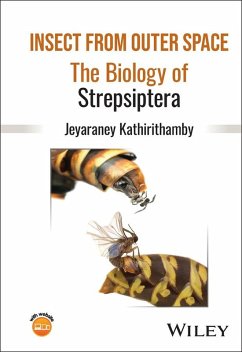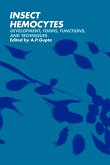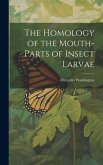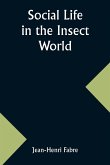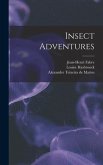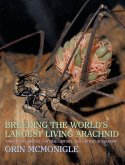- Gebundenes Buch
- Merkliste
- Auf die Merkliste
- Bewerten Bewerten
- Teilen
- Produkt teilen
- Produkterinnerung
- Produkterinnerung
Comprehensive account of Strepsiptera biology, including their taxonomy, morphology, fine structure, physiology, and behaviour, ranging from genes to phylogeny Beautifully illustrated in full color throughout, with original up-to-date material from the author's research collection, Insect from Outer Space: The Biology of Strepsiptera is the first book to provide a comprehensive guide to the unique biology of an intriguing group of parasitoids that, until relatively recently, have remained something of a mystery in terms of both phenotype and genotype. The author explores the exciting biology…mehr
Andere Kunden interessierten sich auch für
![Insect Hydrocarbons Insect Hydrocarbons]() Insect Hydrocarbons169,99 €
Insect Hydrocarbons169,99 €![Insect Hemocytes Insect Hemocytes]() Insect Hemocytes68,99 €
Insect Hemocytes68,99 €![The Homology of the Mouth-parts of Insect Larvae The Homology of the Mouth-parts of Insect Larvae]() Margaret WashingtonThe Homology of the Mouth-parts of Insect Larvae32,99 €
Margaret WashingtonThe Homology of the Mouth-parts of Insect Larvae32,99 €![Social Life in the Insect World Social Life in the Insect World]() Jean-Henri FabreSocial Life in the Insect World26,99 €
Jean-Henri FabreSocial Life in the Insect World26,99 €![Insect Adventures Insect Adventures]() Louise Hasbrouck ZimmInsect Adventures31,99 €
Louise Hasbrouck ZimmInsect Adventures31,99 €![Hormones and Metabolism in Insect Stress Hormones and Metabolism in Insect Stress]() Jelisaveta IvanovicHormones and Metabolism in Insect Stress115,99 €
Jelisaveta IvanovicHormones and Metabolism in Insect Stress115,99 €![Breeding the World's Largest Living Arachnid Breeding the World's Largest Living Arachnid]() Orin McmonigleBreeding the World's Largest Living Arachnid84,99 €
Orin McmonigleBreeding the World's Largest Living Arachnid84,99 €-
-
-
Comprehensive account of Strepsiptera biology, including their taxonomy, morphology, fine structure, physiology, and behaviour, ranging from genes to phylogeny Beautifully illustrated in full color throughout, with original up-to-date material from the author's research collection, Insect from Outer Space: The Biology of Strepsiptera is the first book to provide a comprehensive guide to the unique biology of an intriguing group of parasitoids that, until relatively recently, have remained something of a mystery in terms of both phenotype and genotype. The author explores the exciting biology and life history of these extraordinary insect parasitoids. In addition, the book provides a history of each family, and an account of the questions surrounding the evolution of Strepsiptera, explaining their position within the phylogeny of insects. Written by a leading international expert in the field, this book includes information on: * Strepsiptera, which are among the least species-rich insect parasitoids, but they parasitise hosts from seven orders and 36 families of insects * The two examples of polyphensim that Strepsiptera exhibit are: i) free-living planidia that moult to endoparasitic larvae; and ii) the neotenic females of derived families * Adult males are free-living, while females are free-living in primitive families, and are endoparasitic and neotenic in derived families * Metamorphosis is a crucial process in the evolution of the sexually dimorphic Strepsiptera, and the neotenic females in derived families undergo a metamorphic transformation in the cephalothoracic region * Differences in Strepsiptera life cycles between the suborders Mengenillidia (a more ancestral lineage) and Stylopidia (a recent suborder) Insect from Outer Space: The Biology of Strepsiptera is an essential reference work for entomologists and biologists alike who seek to unravel the secrets of these extraordinary creatures. The text is also an excellent learning resource for graduate and undergraduate students because the unique biology of Strepsiptera answers a wide range of biological questions.
Produktdetails
- Produktdetails
- Verlag: John Wiley & Sons Inc
- Seitenzahl: 496
- Erscheinungstermin: 21. August 2025
- Englisch
- Abmessung: 244mm x 170mm
- ISBN-13: 9781118406519
- ISBN-10: 1118406516
- Artikelnr.: 63820158
- Herstellerkennzeichnung
- Libri GmbH
- Europaallee 1
- 36244 Bad Hersfeld
- gpsr@libri.de
- Verlag: John Wiley & Sons Inc
- Seitenzahl: 496
- Erscheinungstermin: 21. August 2025
- Englisch
- Abmessung: 244mm x 170mm
- ISBN-13: 9781118406519
- ISBN-10: 1118406516
- Artikelnr.: 63820158
- Herstellerkennzeichnung
- Libri GmbH
- Europaallee 1
- 36244 Bad Hersfeld
- gpsr@libri.de
Jeyaraney Kathirithamby, Department of Biology and St Hugh's College, University of Oxford, UK.
Preface xiii
About the Companion Website xvii
1 Order Strepsiptera 1
1.1 Introduction 1
1.2 Are Strepsiptera Parasites or Parasitoids? 10
1.3 Trichotomous Hypothesis of Insect Parasitoids 11
1.4 Metamorphosis 14
References 16
2 History of Strepsiptera 23
References 33
3 Collection 39
3.1 Introduction 39
3.2 Stylopised Leaf- and Planthoppers 39
3.3 Stylopised Eusocial Wasps 40
3.4 Stylopised Grasshoppers/Crickets/Mantids 41
3.5 Stylopised Silverfish 42
References 43
4 Phylogeny 45
4.1 Phylogenetic Position on the Tree of Life 45
4.2 Phylogeny of Strepsiptera 49
4.3 Mitochondrial Genomes 53
References 56
5 Fossil Species 63
5.1 Introduction 63
5.2 Families: Protoxenidae, Phthanoxenidae and Cretostylopidae 67
5.3 Family Mengeidae 69
5.4 Planidia from Cretaceous Amber 71
5.5 Planidium from Eocene Baltic Amber 72
5.6 Males in Eocene Baltic Amber 72
5.7 Males in Compressed Shale 73
5.8 Male in Fushun Amber 76
5.9 Males in Miocene Amber 76
5.10 Male in Madagascar Copal 80
5.11 Fossil Strepsiptera and Their Hosts 80
5.12 Biology of Fossil Strepsiptera 81
References 82
6 First Instar Free- Living Planidium 87
6.1 Introduction 87
6.2 History 89
6.3 Biology and Life History 90
6.4 Birth of Planidia 93
6.5 Locomotion 93
6.6 Entry into Host 94
6.7 Host Defence 97
6.8 Moulting After Host Entry 97
6.9 Dispersal 98
6.9.1 Phoretic Transmission 98
6.9.2 Mass/Direct Release 101
6.10 Planidia Found in Unusual Destinations 101
References 102
7 Endoparasitic Larval Stages 111
7.1 Introduction 111
7.2 Apolysis Without Ecdysis 111
7.3 Life History 115
7.3.1 Endoparasitic Second Instar Larva 115
7.3.2 Endoparasitic Third Instar Larva 115
7.3.3 Endoparasitic Fourth Instar Larva 116
7.4 Internal Development 118
7.5 Emergence and Extrusion Through Host Cuticle 121
7.6 Avirulence 121
7.7 Immune Defence 123
7.7.1 Masquerading as 'Self' 123
References 126
8 Pupal Stage 133
8.1 Introduction 133
8.2 Free - Living Puparium of Male and Female Mengenillidae 133
8.3 Partially Endoparasitic Male Puparium of Stylopidia 136
8.4 Pre-formed 'Line of Weakness' in Male Puparium of Stylopidia 137
8.5 Development of the Eye in Male Pupa of Stylopidia 140
8.6 Development of the Reproductive System in Male Pupa of Stylopidia 141
8.7 Absence of the Pupal Instar in Female Stylopiformia 141
References 145
9 Adult Male 149
9.1 Introduction 149
9.2 Biology and Life History 152
9.2.1 Head 152
9.2.2 Eyes 153
9.2.3 Thorax 157
9.2.4 Abdomen 161
9.2.5 Reproductive System 163
9.3 Emergence of Free- Living Male from the Puparium 167
9.3.1 Contractions 167
9.3.2 Frontal Sac 167
9.3.3 Mandibles 168
References 169
10 Free- Living Female Mengenillidae and Neotenic Female Stylopidia 177
10.1 Introduction 177
10.2 Free- Living Female Mengenillidae 179
10.3 Endoparasitic, Neotenic Female Stylopidia 180
10.3.1 Reproductive System in Stylopidia 184
10.4 Metamorphic Transformation of the Cephalothorax 186
10.4.1 Developmental Process in Stylopidia 192
10.5 Multiple Cuticles of the Endoparasitic, Neotenic Female Stylopidia 195
10.6 Brood Canal System in Stylopidia 196
10.6.1 Invagination in the Brood Canal of Stylops 198
10.7 Birth of Planidia in Mengenillidae and Stylopidia 199
10.8 Nassonov's Glands 199
10.8.1 Structure of Nassonov's Glands 199
10.8.2 Pheromone 202
10.8.3 Structure of the Pheromone 203
References 204
11 Mating 213
11.1 Introduction 213
11.2 Maturation of Male and Female 213
11.3 Female 'Calling' Behaviour and Attraction 214
11.4 Adult Male Emergence and Behaviour Before Mating 217
11.5 Behaviour of Male During Mating 218
11.6 Insemination 219
11.6.1 Traumatic Insemination in Mengenillidae 223
11.6.2 Brood Canal Insemination in Stylopidia 223
11.7 Receptor Systems and Signals During Sexual Communication 225
11.7.1 Antennae and Maxillary Palps 225
11.7.2 Tarsi 225
11.7.3 Hairs on Aedeagus 226
11.8 Reproductive Synchrony 226
References 228
12 Basal Extant Families: Family Bahiaxenidae 235
12.1 Introduction and Taxonomy 235
Reference 235
13 Family Mengenillidae 237
13.1 Introduction 237
13.2 Taxonomy 242
13.3 Biology and Life History 245
13.4 Birth and Emergence of Planidia from a Free- Living, Neotenic Female
247
13.4.1 Neotenic Female that Remains in the Puparium 247
13.4.2 Birth and Emergence of Planidia from a Female that Remains in the
Puparium 248
13.5 Hosts 249
13.6 Entomophagous Parasites 250
13.7 Nematode Parasites 251
References 252
14 Suborder Stylopidia: Family Corioxenidae 257
14.1 Introduction 257
14.2 Taxonomy 257
14.3 Extrusion of the Cephalotheca and Cephalothorax 260
14.4 Emergence of Male 262
14.5 Unusual Insemination 262
14.6 Emergence of Planidia 263
14.7 Unusual Life Cycle and Super-stylopisation in Blissoxenos 264
14.8 Dispersal of Planidia 267
14.9 Morphological Changes of Stylopised Corioxenidae 267
14.10 Corioxenidae as Biocontrol Agents 268
References 268
15 Infraorder Stylopiformia: Myrmecolacidae 273
15.1 Introduction 273
15.2 Taxonomy 281
15.3 Heterotrophic Heteronomy 285
15.4 Behaviour of Stylopised Ants 288
15.5 Host- Seeking Behaviour of Planidia with Dimorphic Hosts 290
15.6 Cryptic Diversity 291
15.7 Partitioning of Genetic Diversity and Patterns of Host Specificity 292
15.8 Biogeography 299
15.9 Origin of Caenocholax in United States 300
15.10 Multi-parasitism 301
15.11 Myrmecolacidae as Biocontrol Agents 301
References 303
16.1 Family Lychnocolacidae 313
16.1.1 Introduction 313
References 314
16.2 Family Bohartillidae 316
16.2.1 Introduction 316
References 317
17 Family Stylopidae 319
17.1 Introduction 319
17.2 Taxonomy 322
17.3 Prevalence of Stylopisation 324
17.4 Morphological Changes in Stylopised Hosts 324
17.5 Pheromone 327
17.6 Behavioural Changes in Stylopised Hosts 329
17.7 Protandry 330
17.8 Phoretic Transmission 333
17.9 Host- seeking by Planidia 337
17.10 Super-stylopisation 337
17.11 Multi-parasitisim 338
17.12 Cryptic Species and Host Specificity 339
References 341
18 Family Xenidae 351
18.1 Introduction 351
18.2 Taxonomy 354
18.3 Inquilines 359
18.4 Life Cycle of Xenos in Relation to Colony Cycle of Host 360
18.5 Infective Stages of Host 364
18.6 Stylopisation of Polistes in Native and Invasive Ranges 365
18.7 Prevalence 366
18.8 Morphological Changes in Styopised Hosts 369
18.9 Behavioural Changes in Stylopised Hosts 372
18.9.1 Extranidal Aggregations 372
18.9.2 Extended Phenotype 375
18.10 Voltinism 376
18.11 Extension of Life Cycle of Stylopised Host 378
18.12 Virulence 381
18.13 Encapsulation 383
18.14 Effect of Stylopisation on Status Badges 384
18.15 Cuticular Hydrocarbons in Stylopised Hosts 385
18.16 Mechanism of Transfer of Planidia to Nests 385
18.16.1 Phoretic Transmission 386
18.16.2 Mass/Direct Release 390
18.17 Super-stylopisation 391
18.18 Co- Habitation 392
18.19 Phylogeny, Cryptic Species and Host Specificity 392
References 394
19 Family Elenchidae 417
19.1 Introduction and History 417
19.2 Taxonomy 419
19.3 Biology and Life History 421
19.4 Morphological Changes in Stylopised Hosts 423
19.5 Super-stylopisation 424
19.6 Mulit-parasitism 425
19.7 Cryptic Species and Host Specificity 425
19.8 Elenchus as Biocontrol Agents 426
19.9 Wolbachia Endosymbionts 426
References 428
20 Family Halictophagidae 435
20.1 Introduction 435
20.2 Taxonomy 436
20.3 Biology and Life History 441
20.4 Morphological Changes in Stylopised Hosts 444
20.5 Super-stylopisation 444
20.6 Multi-parasitism 444
20.7 Halictophagidae as Biocontrol Agents 445
20.8 Wolbachia Endosymbionts 446
References 449
Index 459
About the Companion Website xvii
1 Order Strepsiptera 1
1.1 Introduction 1
1.2 Are Strepsiptera Parasites or Parasitoids? 10
1.3 Trichotomous Hypothesis of Insect Parasitoids 11
1.4 Metamorphosis 14
References 16
2 History of Strepsiptera 23
References 33
3 Collection 39
3.1 Introduction 39
3.2 Stylopised Leaf- and Planthoppers 39
3.3 Stylopised Eusocial Wasps 40
3.4 Stylopised Grasshoppers/Crickets/Mantids 41
3.5 Stylopised Silverfish 42
References 43
4 Phylogeny 45
4.1 Phylogenetic Position on the Tree of Life 45
4.2 Phylogeny of Strepsiptera 49
4.3 Mitochondrial Genomes 53
References 56
5 Fossil Species 63
5.1 Introduction 63
5.2 Families: Protoxenidae, Phthanoxenidae and Cretostylopidae 67
5.3 Family Mengeidae 69
5.4 Planidia from Cretaceous Amber 71
5.5 Planidium from Eocene Baltic Amber 72
5.6 Males in Eocene Baltic Amber 72
5.7 Males in Compressed Shale 73
5.8 Male in Fushun Amber 76
5.9 Males in Miocene Amber 76
5.10 Male in Madagascar Copal 80
5.11 Fossil Strepsiptera and Their Hosts 80
5.12 Biology of Fossil Strepsiptera 81
References 82
6 First Instar Free- Living Planidium 87
6.1 Introduction 87
6.2 History 89
6.3 Biology and Life History 90
6.4 Birth of Planidia 93
6.5 Locomotion 93
6.6 Entry into Host 94
6.7 Host Defence 97
6.8 Moulting After Host Entry 97
6.9 Dispersal 98
6.9.1 Phoretic Transmission 98
6.9.2 Mass/Direct Release 101
6.10 Planidia Found in Unusual Destinations 101
References 102
7 Endoparasitic Larval Stages 111
7.1 Introduction 111
7.2 Apolysis Without Ecdysis 111
7.3 Life History 115
7.3.1 Endoparasitic Second Instar Larva 115
7.3.2 Endoparasitic Third Instar Larva 115
7.3.3 Endoparasitic Fourth Instar Larva 116
7.4 Internal Development 118
7.5 Emergence and Extrusion Through Host Cuticle 121
7.6 Avirulence 121
7.7 Immune Defence 123
7.7.1 Masquerading as 'Self' 123
References 126
8 Pupal Stage 133
8.1 Introduction 133
8.2 Free - Living Puparium of Male and Female Mengenillidae 133
8.3 Partially Endoparasitic Male Puparium of Stylopidia 136
8.4 Pre-formed 'Line of Weakness' in Male Puparium of Stylopidia 137
8.5 Development of the Eye in Male Pupa of Stylopidia 140
8.6 Development of the Reproductive System in Male Pupa of Stylopidia 141
8.7 Absence of the Pupal Instar in Female Stylopiformia 141
References 145
9 Adult Male 149
9.1 Introduction 149
9.2 Biology and Life History 152
9.2.1 Head 152
9.2.2 Eyes 153
9.2.3 Thorax 157
9.2.4 Abdomen 161
9.2.5 Reproductive System 163
9.3 Emergence of Free- Living Male from the Puparium 167
9.3.1 Contractions 167
9.3.2 Frontal Sac 167
9.3.3 Mandibles 168
References 169
10 Free- Living Female Mengenillidae and Neotenic Female Stylopidia 177
10.1 Introduction 177
10.2 Free- Living Female Mengenillidae 179
10.3 Endoparasitic, Neotenic Female Stylopidia 180
10.3.1 Reproductive System in Stylopidia 184
10.4 Metamorphic Transformation of the Cephalothorax 186
10.4.1 Developmental Process in Stylopidia 192
10.5 Multiple Cuticles of the Endoparasitic, Neotenic Female Stylopidia 195
10.6 Brood Canal System in Stylopidia 196
10.6.1 Invagination in the Brood Canal of Stylops 198
10.7 Birth of Planidia in Mengenillidae and Stylopidia 199
10.8 Nassonov's Glands 199
10.8.1 Structure of Nassonov's Glands 199
10.8.2 Pheromone 202
10.8.3 Structure of the Pheromone 203
References 204
11 Mating 213
11.1 Introduction 213
11.2 Maturation of Male and Female 213
11.3 Female 'Calling' Behaviour and Attraction 214
11.4 Adult Male Emergence and Behaviour Before Mating 217
11.5 Behaviour of Male During Mating 218
11.6 Insemination 219
11.6.1 Traumatic Insemination in Mengenillidae 223
11.6.2 Brood Canal Insemination in Stylopidia 223
11.7 Receptor Systems and Signals During Sexual Communication 225
11.7.1 Antennae and Maxillary Palps 225
11.7.2 Tarsi 225
11.7.3 Hairs on Aedeagus 226
11.8 Reproductive Synchrony 226
References 228
12 Basal Extant Families: Family Bahiaxenidae 235
12.1 Introduction and Taxonomy 235
Reference 235
13 Family Mengenillidae 237
13.1 Introduction 237
13.2 Taxonomy 242
13.3 Biology and Life History 245
13.4 Birth and Emergence of Planidia from a Free- Living, Neotenic Female
247
13.4.1 Neotenic Female that Remains in the Puparium 247
13.4.2 Birth and Emergence of Planidia from a Female that Remains in the
Puparium 248
13.5 Hosts 249
13.6 Entomophagous Parasites 250
13.7 Nematode Parasites 251
References 252
14 Suborder Stylopidia: Family Corioxenidae 257
14.1 Introduction 257
14.2 Taxonomy 257
14.3 Extrusion of the Cephalotheca and Cephalothorax 260
14.4 Emergence of Male 262
14.5 Unusual Insemination 262
14.6 Emergence of Planidia 263
14.7 Unusual Life Cycle and Super-stylopisation in Blissoxenos 264
14.8 Dispersal of Planidia 267
14.9 Morphological Changes of Stylopised Corioxenidae 267
14.10 Corioxenidae as Biocontrol Agents 268
References 268
15 Infraorder Stylopiformia: Myrmecolacidae 273
15.1 Introduction 273
15.2 Taxonomy 281
15.3 Heterotrophic Heteronomy 285
15.4 Behaviour of Stylopised Ants 288
15.5 Host- Seeking Behaviour of Planidia with Dimorphic Hosts 290
15.6 Cryptic Diversity 291
15.7 Partitioning of Genetic Diversity and Patterns of Host Specificity 292
15.8 Biogeography 299
15.9 Origin of Caenocholax in United States 300
15.10 Multi-parasitism 301
15.11 Myrmecolacidae as Biocontrol Agents 301
References 303
16.1 Family Lychnocolacidae 313
16.1.1 Introduction 313
References 314
16.2 Family Bohartillidae 316
16.2.1 Introduction 316
References 317
17 Family Stylopidae 319
17.1 Introduction 319
17.2 Taxonomy 322
17.3 Prevalence of Stylopisation 324
17.4 Morphological Changes in Stylopised Hosts 324
17.5 Pheromone 327
17.6 Behavioural Changes in Stylopised Hosts 329
17.7 Protandry 330
17.8 Phoretic Transmission 333
17.9 Host- seeking by Planidia 337
17.10 Super-stylopisation 337
17.11 Multi-parasitisim 338
17.12 Cryptic Species and Host Specificity 339
References 341
18 Family Xenidae 351
18.1 Introduction 351
18.2 Taxonomy 354
18.3 Inquilines 359
18.4 Life Cycle of Xenos in Relation to Colony Cycle of Host 360
18.5 Infective Stages of Host 364
18.6 Stylopisation of Polistes in Native and Invasive Ranges 365
18.7 Prevalence 366
18.8 Morphological Changes in Styopised Hosts 369
18.9 Behavioural Changes in Stylopised Hosts 372
18.9.1 Extranidal Aggregations 372
18.9.2 Extended Phenotype 375
18.10 Voltinism 376
18.11 Extension of Life Cycle of Stylopised Host 378
18.12 Virulence 381
18.13 Encapsulation 383
18.14 Effect of Stylopisation on Status Badges 384
18.15 Cuticular Hydrocarbons in Stylopised Hosts 385
18.16 Mechanism of Transfer of Planidia to Nests 385
18.16.1 Phoretic Transmission 386
18.16.2 Mass/Direct Release 390
18.17 Super-stylopisation 391
18.18 Co- Habitation 392
18.19 Phylogeny, Cryptic Species and Host Specificity 392
References 394
19 Family Elenchidae 417
19.1 Introduction and History 417
19.2 Taxonomy 419
19.3 Biology and Life History 421
19.4 Morphological Changes in Stylopised Hosts 423
19.5 Super-stylopisation 424
19.6 Mulit-parasitism 425
19.7 Cryptic Species and Host Specificity 425
19.8 Elenchus as Biocontrol Agents 426
19.9 Wolbachia Endosymbionts 426
References 428
20 Family Halictophagidae 435
20.1 Introduction 435
20.2 Taxonomy 436
20.3 Biology and Life History 441
20.4 Morphological Changes in Stylopised Hosts 444
20.5 Super-stylopisation 444
20.6 Multi-parasitism 444
20.7 Halictophagidae as Biocontrol Agents 445
20.8 Wolbachia Endosymbionts 446
References 449
Index 459
Preface xiii
About the Companion Website xvii
1 Order Strepsiptera 1
1.1 Introduction 1
1.2 Are Strepsiptera Parasites or Parasitoids? 10
1.3 Trichotomous Hypothesis of Insect Parasitoids 11
1.4 Metamorphosis 14
References 16
2 History of Strepsiptera 23
References 33
3 Collection 39
3.1 Introduction 39
3.2 Stylopised Leaf- and Planthoppers 39
3.3 Stylopised Eusocial Wasps 40
3.4 Stylopised Grasshoppers/Crickets/Mantids 41
3.5 Stylopised Silverfish 42
References 43
4 Phylogeny 45
4.1 Phylogenetic Position on the Tree of Life 45
4.2 Phylogeny of Strepsiptera 49
4.3 Mitochondrial Genomes 53
References 56
5 Fossil Species 63
5.1 Introduction 63
5.2 Families: Protoxenidae, Phthanoxenidae and Cretostylopidae 67
5.3 Family Mengeidae 69
5.4 Planidia from Cretaceous Amber 71
5.5 Planidium from Eocene Baltic Amber 72
5.6 Males in Eocene Baltic Amber 72
5.7 Males in Compressed Shale 73
5.8 Male in Fushun Amber 76
5.9 Males in Miocene Amber 76
5.10 Male in Madagascar Copal 80
5.11 Fossil Strepsiptera and Their Hosts 80
5.12 Biology of Fossil Strepsiptera 81
References 82
6 First Instar Free- Living Planidium 87
6.1 Introduction 87
6.2 History 89
6.3 Biology and Life History 90
6.4 Birth of Planidia 93
6.5 Locomotion 93
6.6 Entry into Host 94
6.7 Host Defence 97
6.8 Moulting After Host Entry 97
6.9 Dispersal 98
6.9.1 Phoretic Transmission 98
6.9.2 Mass/Direct Release 101
6.10 Planidia Found in Unusual Destinations 101
References 102
7 Endoparasitic Larval Stages 111
7.1 Introduction 111
7.2 Apolysis Without Ecdysis 111
7.3 Life History 115
7.3.1 Endoparasitic Second Instar Larva 115
7.3.2 Endoparasitic Third Instar Larva 115
7.3.3 Endoparasitic Fourth Instar Larva 116
7.4 Internal Development 118
7.5 Emergence and Extrusion Through Host Cuticle 121
7.6 Avirulence 121
7.7 Immune Defence 123
7.7.1 Masquerading as 'Self' 123
References 126
8 Pupal Stage 133
8.1 Introduction 133
8.2 Free - Living Puparium of Male and Female Mengenillidae 133
8.3 Partially Endoparasitic Male Puparium of Stylopidia 136
8.4 Pre-formed 'Line of Weakness' in Male Puparium of Stylopidia 137
8.5 Development of the Eye in Male Pupa of Stylopidia 140
8.6 Development of the Reproductive System in Male Pupa of Stylopidia 141
8.7 Absence of the Pupal Instar in Female Stylopiformia 141
References 145
9 Adult Male 149
9.1 Introduction 149
9.2 Biology and Life History 152
9.2.1 Head 152
9.2.2 Eyes 153
9.2.3 Thorax 157
9.2.4 Abdomen 161
9.2.5 Reproductive System 163
9.3 Emergence of Free- Living Male from the Puparium 167
9.3.1 Contractions 167
9.3.2 Frontal Sac 167
9.3.3 Mandibles 168
References 169
10 Free- Living Female Mengenillidae and Neotenic Female Stylopidia 177
10.1 Introduction 177
10.2 Free- Living Female Mengenillidae 179
10.3 Endoparasitic, Neotenic Female Stylopidia 180
10.3.1 Reproductive System in Stylopidia 184
10.4 Metamorphic Transformation of the Cephalothorax 186
10.4.1 Developmental Process in Stylopidia 192
10.5 Multiple Cuticles of the Endoparasitic, Neotenic Female Stylopidia 195
10.6 Brood Canal System in Stylopidia 196
10.6.1 Invagination in the Brood Canal of Stylops 198
10.7 Birth of Planidia in Mengenillidae and Stylopidia 199
10.8 Nassonov's Glands 199
10.8.1 Structure of Nassonov's Glands 199
10.8.2 Pheromone 202
10.8.3 Structure of the Pheromone 203
References 204
11 Mating 213
11.1 Introduction 213
11.2 Maturation of Male and Female 213
11.3 Female 'Calling' Behaviour and Attraction 214
11.4 Adult Male Emergence and Behaviour Before Mating 217
11.5 Behaviour of Male During Mating 218
11.6 Insemination 219
11.6.1 Traumatic Insemination in Mengenillidae 223
11.6.2 Brood Canal Insemination in Stylopidia 223
11.7 Receptor Systems and Signals During Sexual Communication 225
11.7.1 Antennae and Maxillary Palps 225
11.7.2 Tarsi 225
11.7.3 Hairs on Aedeagus 226
11.8 Reproductive Synchrony 226
References 228
12 Basal Extant Families: Family Bahiaxenidae 235
12.1 Introduction and Taxonomy 235
Reference 235
13 Family Mengenillidae 237
13.1 Introduction 237
13.2 Taxonomy 242
13.3 Biology and Life History 245
13.4 Birth and Emergence of Planidia from a Free- Living, Neotenic Female
247
13.4.1 Neotenic Female that Remains in the Puparium 247
13.4.2 Birth and Emergence of Planidia from a Female that Remains in the
Puparium 248
13.5 Hosts 249
13.6 Entomophagous Parasites 250
13.7 Nematode Parasites 251
References 252
14 Suborder Stylopidia: Family Corioxenidae 257
14.1 Introduction 257
14.2 Taxonomy 257
14.3 Extrusion of the Cephalotheca and Cephalothorax 260
14.4 Emergence of Male 262
14.5 Unusual Insemination 262
14.6 Emergence of Planidia 263
14.7 Unusual Life Cycle and Super-stylopisation in Blissoxenos 264
14.8 Dispersal of Planidia 267
14.9 Morphological Changes of Stylopised Corioxenidae 267
14.10 Corioxenidae as Biocontrol Agents 268
References 268
15 Infraorder Stylopiformia: Myrmecolacidae 273
15.1 Introduction 273
15.2 Taxonomy 281
15.3 Heterotrophic Heteronomy 285
15.4 Behaviour of Stylopised Ants 288
15.5 Host- Seeking Behaviour of Planidia with Dimorphic Hosts 290
15.6 Cryptic Diversity 291
15.7 Partitioning of Genetic Diversity and Patterns of Host Specificity 292
15.8 Biogeography 299
15.9 Origin of Caenocholax in United States 300
15.10 Multi-parasitism 301
15.11 Myrmecolacidae as Biocontrol Agents 301
References 303
16.1 Family Lychnocolacidae 313
16.1.1 Introduction 313
References 314
16.2 Family Bohartillidae 316
16.2.1 Introduction 316
References 317
17 Family Stylopidae 319
17.1 Introduction 319
17.2 Taxonomy 322
17.3 Prevalence of Stylopisation 324
17.4 Morphological Changes in Stylopised Hosts 324
17.5 Pheromone 327
17.6 Behavioural Changes in Stylopised Hosts 329
17.7 Protandry 330
17.8 Phoretic Transmission 333
17.9 Host- seeking by Planidia 337
17.10 Super-stylopisation 337
17.11 Multi-parasitisim 338
17.12 Cryptic Species and Host Specificity 339
References 341
18 Family Xenidae 351
18.1 Introduction 351
18.2 Taxonomy 354
18.3 Inquilines 359
18.4 Life Cycle of Xenos in Relation to Colony Cycle of Host 360
18.5 Infective Stages of Host 364
18.6 Stylopisation of Polistes in Native and Invasive Ranges 365
18.7 Prevalence 366
18.8 Morphological Changes in Styopised Hosts 369
18.9 Behavioural Changes in Stylopised Hosts 372
18.9.1 Extranidal Aggregations 372
18.9.2 Extended Phenotype 375
18.10 Voltinism 376
18.11 Extension of Life Cycle of Stylopised Host 378
18.12 Virulence 381
18.13 Encapsulation 383
18.14 Effect of Stylopisation on Status Badges 384
18.15 Cuticular Hydrocarbons in Stylopised Hosts 385
18.16 Mechanism of Transfer of Planidia to Nests 385
18.16.1 Phoretic Transmission 386
18.16.2 Mass/Direct Release 390
18.17 Super-stylopisation 391
18.18 Co- Habitation 392
18.19 Phylogeny, Cryptic Species and Host Specificity 392
References 394
19 Family Elenchidae 417
19.1 Introduction and History 417
19.2 Taxonomy 419
19.3 Biology and Life History 421
19.4 Morphological Changes in Stylopised Hosts 423
19.5 Super-stylopisation 424
19.6 Mulit-parasitism 425
19.7 Cryptic Species and Host Specificity 425
19.8 Elenchus as Biocontrol Agents 426
19.9 Wolbachia Endosymbionts 426
References 428
20 Family Halictophagidae 435
20.1 Introduction 435
20.2 Taxonomy 436
20.3 Biology and Life History 441
20.4 Morphological Changes in Stylopised Hosts 444
20.5 Super-stylopisation 444
20.6 Multi-parasitism 444
20.7 Halictophagidae as Biocontrol Agents 445
20.8 Wolbachia Endosymbionts 446
References 449
Index 459
About the Companion Website xvii
1 Order Strepsiptera 1
1.1 Introduction 1
1.2 Are Strepsiptera Parasites or Parasitoids? 10
1.3 Trichotomous Hypothesis of Insect Parasitoids 11
1.4 Metamorphosis 14
References 16
2 History of Strepsiptera 23
References 33
3 Collection 39
3.1 Introduction 39
3.2 Stylopised Leaf- and Planthoppers 39
3.3 Stylopised Eusocial Wasps 40
3.4 Stylopised Grasshoppers/Crickets/Mantids 41
3.5 Stylopised Silverfish 42
References 43
4 Phylogeny 45
4.1 Phylogenetic Position on the Tree of Life 45
4.2 Phylogeny of Strepsiptera 49
4.3 Mitochondrial Genomes 53
References 56
5 Fossil Species 63
5.1 Introduction 63
5.2 Families: Protoxenidae, Phthanoxenidae and Cretostylopidae 67
5.3 Family Mengeidae 69
5.4 Planidia from Cretaceous Amber 71
5.5 Planidium from Eocene Baltic Amber 72
5.6 Males in Eocene Baltic Amber 72
5.7 Males in Compressed Shale 73
5.8 Male in Fushun Amber 76
5.9 Males in Miocene Amber 76
5.10 Male in Madagascar Copal 80
5.11 Fossil Strepsiptera and Their Hosts 80
5.12 Biology of Fossil Strepsiptera 81
References 82
6 First Instar Free- Living Planidium 87
6.1 Introduction 87
6.2 History 89
6.3 Biology and Life History 90
6.4 Birth of Planidia 93
6.5 Locomotion 93
6.6 Entry into Host 94
6.7 Host Defence 97
6.8 Moulting After Host Entry 97
6.9 Dispersal 98
6.9.1 Phoretic Transmission 98
6.9.2 Mass/Direct Release 101
6.10 Planidia Found in Unusual Destinations 101
References 102
7 Endoparasitic Larval Stages 111
7.1 Introduction 111
7.2 Apolysis Without Ecdysis 111
7.3 Life History 115
7.3.1 Endoparasitic Second Instar Larva 115
7.3.2 Endoparasitic Third Instar Larva 115
7.3.3 Endoparasitic Fourth Instar Larva 116
7.4 Internal Development 118
7.5 Emergence and Extrusion Through Host Cuticle 121
7.6 Avirulence 121
7.7 Immune Defence 123
7.7.1 Masquerading as 'Self' 123
References 126
8 Pupal Stage 133
8.1 Introduction 133
8.2 Free - Living Puparium of Male and Female Mengenillidae 133
8.3 Partially Endoparasitic Male Puparium of Stylopidia 136
8.4 Pre-formed 'Line of Weakness' in Male Puparium of Stylopidia 137
8.5 Development of the Eye in Male Pupa of Stylopidia 140
8.6 Development of the Reproductive System in Male Pupa of Stylopidia 141
8.7 Absence of the Pupal Instar in Female Stylopiformia 141
References 145
9 Adult Male 149
9.1 Introduction 149
9.2 Biology and Life History 152
9.2.1 Head 152
9.2.2 Eyes 153
9.2.3 Thorax 157
9.2.4 Abdomen 161
9.2.5 Reproductive System 163
9.3 Emergence of Free- Living Male from the Puparium 167
9.3.1 Contractions 167
9.3.2 Frontal Sac 167
9.3.3 Mandibles 168
References 169
10 Free- Living Female Mengenillidae and Neotenic Female Stylopidia 177
10.1 Introduction 177
10.2 Free- Living Female Mengenillidae 179
10.3 Endoparasitic, Neotenic Female Stylopidia 180
10.3.1 Reproductive System in Stylopidia 184
10.4 Metamorphic Transformation of the Cephalothorax 186
10.4.1 Developmental Process in Stylopidia 192
10.5 Multiple Cuticles of the Endoparasitic, Neotenic Female Stylopidia 195
10.6 Brood Canal System in Stylopidia 196
10.6.1 Invagination in the Brood Canal of Stylops 198
10.7 Birth of Planidia in Mengenillidae and Stylopidia 199
10.8 Nassonov's Glands 199
10.8.1 Structure of Nassonov's Glands 199
10.8.2 Pheromone 202
10.8.3 Structure of the Pheromone 203
References 204
11 Mating 213
11.1 Introduction 213
11.2 Maturation of Male and Female 213
11.3 Female 'Calling' Behaviour and Attraction 214
11.4 Adult Male Emergence and Behaviour Before Mating 217
11.5 Behaviour of Male During Mating 218
11.6 Insemination 219
11.6.1 Traumatic Insemination in Mengenillidae 223
11.6.2 Brood Canal Insemination in Stylopidia 223
11.7 Receptor Systems and Signals During Sexual Communication 225
11.7.1 Antennae and Maxillary Palps 225
11.7.2 Tarsi 225
11.7.3 Hairs on Aedeagus 226
11.8 Reproductive Synchrony 226
References 228
12 Basal Extant Families: Family Bahiaxenidae 235
12.1 Introduction and Taxonomy 235
Reference 235
13 Family Mengenillidae 237
13.1 Introduction 237
13.2 Taxonomy 242
13.3 Biology and Life History 245
13.4 Birth and Emergence of Planidia from a Free- Living, Neotenic Female
247
13.4.1 Neotenic Female that Remains in the Puparium 247
13.4.2 Birth and Emergence of Planidia from a Female that Remains in the
Puparium 248
13.5 Hosts 249
13.6 Entomophagous Parasites 250
13.7 Nematode Parasites 251
References 252
14 Suborder Stylopidia: Family Corioxenidae 257
14.1 Introduction 257
14.2 Taxonomy 257
14.3 Extrusion of the Cephalotheca and Cephalothorax 260
14.4 Emergence of Male 262
14.5 Unusual Insemination 262
14.6 Emergence of Planidia 263
14.7 Unusual Life Cycle and Super-stylopisation in Blissoxenos 264
14.8 Dispersal of Planidia 267
14.9 Morphological Changes of Stylopised Corioxenidae 267
14.10 Corioxenidae as Biocontrol Agents 268
References 268
15 Infraorder Stylopiformia: Myrmecolacidae 273
15.1 Introduction 273
15.2 Taxonomy 281
15.3 Heterotrophic Heteronomy 285
15.4 Behaviour of Stylopised Ants 288
15.5 Host- Seeking Behaviour of Planidia with Dimorphic Hosts 290
15.6 Cryptic Diversity 291
15.7 Partitioning of Genetic Diversity and Patterns of Host Specificity 292
15.8 Biogeography 299
15.9 Origin of Caenocholax in United States 300
15.10 Multi-parasitism 301
15.11 Myrmecolacidae as Biocontrol Agents 301
References 303
16.1 Family Lychnocolacidae 313
16.1.1 Introduction 313
References 314
16.2 Family Bohartillidae 316
16.2.1 Introduction 316
References 317
17 Family Stylopidae 319
17.1 Introduction 319
17.2 Taxonomy 322
17.3 Prevalence of Stylopisation 324
17.4 Morphological Changes in Stylopised Hosts 324
17.5 Pheromone 327
17.6 Behavioural Changes in Stylopised Hosts 329
17.7 Protandry 330
17.8 Phoretic Transmission 333
17.9 Host- seeking by Planidia 337
17.10 Super-stylopisation 337
17.11 Multi-parasitisim 338
17.12 Cryptic Species and Host Specificity 339
References 341
18 Family Xenidae 351
18.1 Introduction 351
18.2 Taxonomy 354
18.3 Inquilines 359
18.4 Life Cycle of Xenos in Relation to Colony Cycle of Host 360
18.5 Infective Stages of Host 364
18.6 Stylopisation of Polistes in Native and Invasive Ranges 365
18.7 Prevalence 366
18.8 Morphological Changes in Styopised Hosts 369
18.9 Behavioural Changes in Stylopised Hosts 372
18.9.1 Extranidal Aggregations 372
18.9.2 Extended Phenotype 375
18.10 Voltinism 376
18.11 Extension of Life Cycle of Stylopised Host 378
18.12 Virulence 381
18.13 Encapsulation 383
18.14 Effect of Stylopisation on Status Badges 384
18.15 Cuticular Hydrocarbons in Stylopised Hosts 385
18.16 Mechanism of Transfer of Planidia to Nests 385
18.16.1 Phoretic Transmission 386
18.16.2 Mass/Direct Release 390
18.17 Super-stylopisation 391
18.18 Co- Habitation 392
18.19 Phylogeny, Cryptic Species and Host Specificity 392
References 394
19 Family Elenchidae 417
19.1 Introduction and History 417
19.2 Taxonomy 419
19.3 Biology and Life History 421
19.4 Morphological Changes in Stylopised Hosts 423
19.5 Super-stylopisation 424
19.6 Mulit-parasitism 425
19.7 Cryptic Species and Host Specificity 425
19.8 Elenchus as Biocontrol Agents 426
19.9 Wolbachia Endosymbionts 426
References 428
20 Family Halictophagidae 435
20.1 Introduction 435
20.2 Taxonomy 436
20.3 Biology and Life History 441
20.4 Morphological Changes in Stylopised Hosts 444
20.5 Super-stylopisation 444
20.6 Multi-parasitism 444
20.7 Halictophagidae as Biocontrol Agents 445
20.8 Wolbachia Endosymbionts 446
References 449
Index 459

